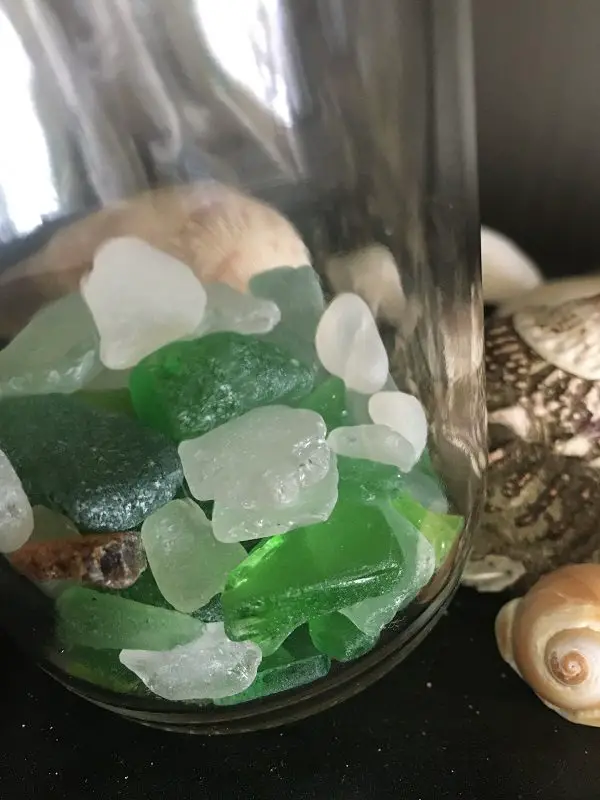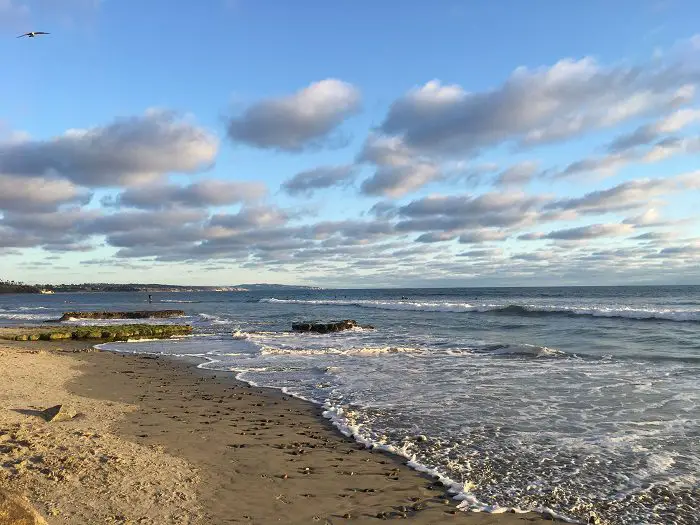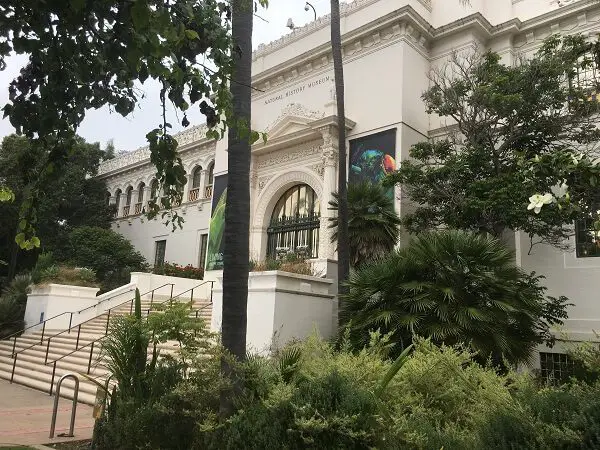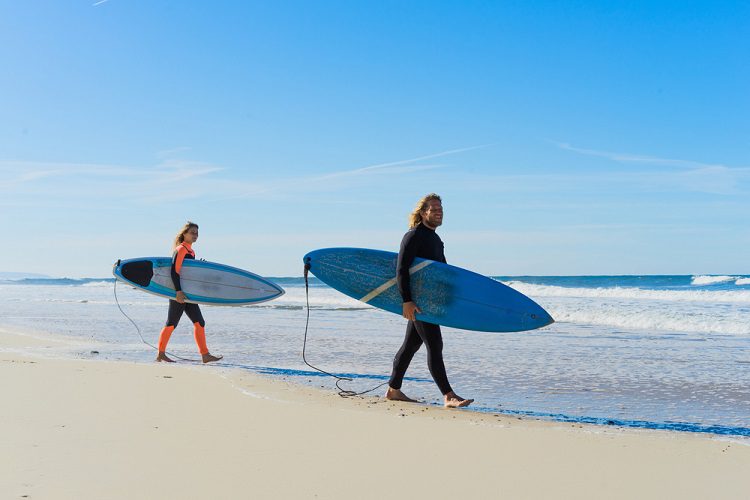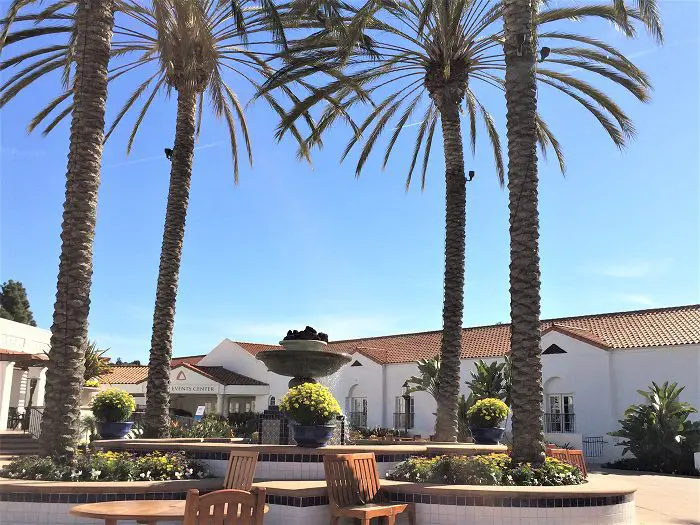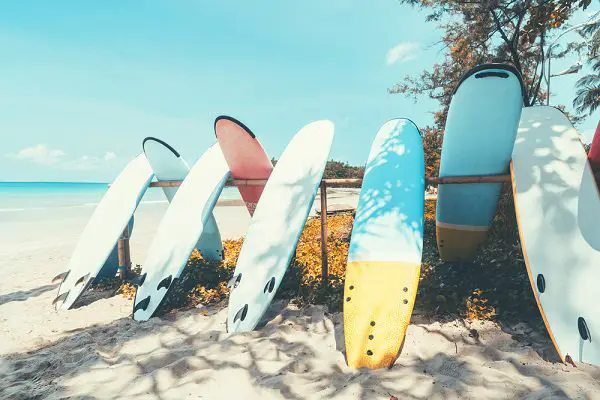Collecting Sea Glass in San Diego
Sea glass in San Diego is very plentiful! Our beaches are a collector’s dream. Here’s what you need to find sea glass in your area:
- The best sea glass hunting is at low tide.
- Search at beaches with plenty of rocks; sea glass is usually hiding out in rock piles & pebbles.
- Many of the beaches from La Jolla to Oceanside have pretty consistent rock piles.
- A sunny day is best since glass will shimmer and you’ll see it better in the rocks.
- Stand with your back to the sun and avoid shadows in the spot where you’re searching.
- We find the most sea glass after high surf warnings and storms.
- You need patience; sea glass is often like finding a needle in a haystack.
- Persistence pays off; once you find your first few pieces, you’ll know what you’re looking for!
I’ve found that any beach here in North County where there are pebbles (which locals call “cobble”) has great potential for sea glass. And collecting sea glass has become one of my obsessions.
I have been a serious collector now for over a year, and it’s been the best therapy for stress and grief that I’ve ever come across.
So far, my husband and I have found sea glass at every beach in North County. The most popular ones for collecting sea glass in San Diego are definitely those with crazy surf and plenty of rocks.
* This post contains affiliate/partner links. If you click and purchase, we may earn a small commission.
Table of Contents
What is sea glass made of?
Have you ever seen something that’s not really a pebble, shell, or regular glass while combing the beach for treasures? If so, and it had some color to it, or looked like it was once glass — you likely spotted some sea glass.
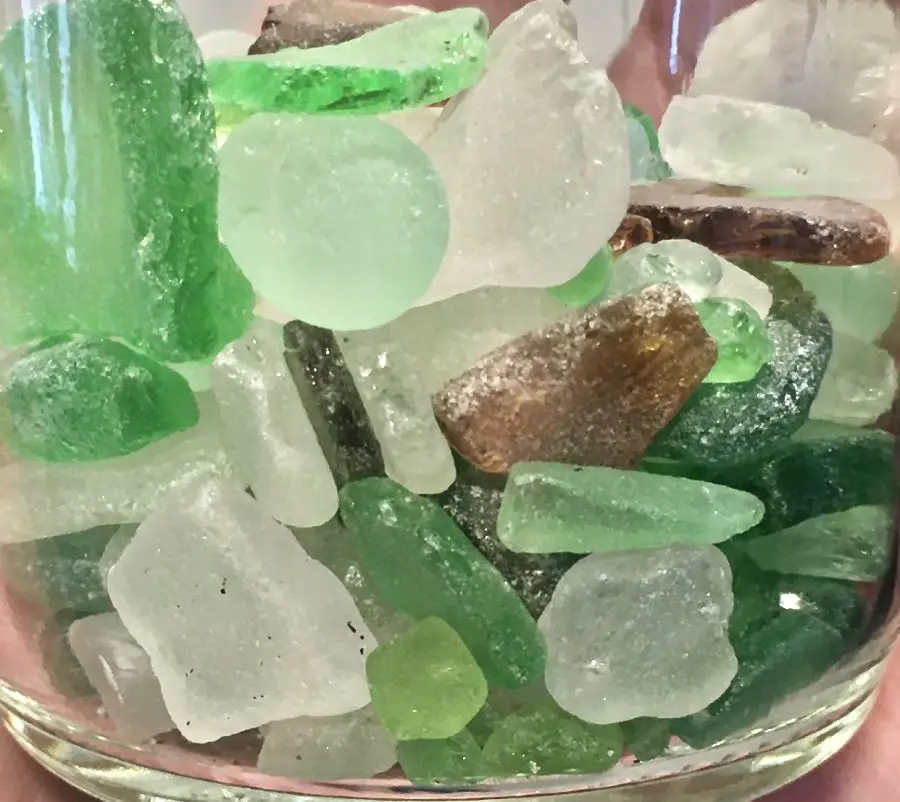
In decades and centuries past, many beauty products, health remedies, and cleaning supplies were produced in glass bottles of all colors and sizes.
There were also glass light covers on various parts of ships and cars and many types of glass dishware and drinking cups.
Of course, we have plenty of colored and clear glass on the shelves of our stores today in the form of soda, sauces, and various types of booze and wine bottles.
No matter where it originated, there are millions of shards of glass that have made it into the ocean. Whether by dumping (which used to be common practice), accidents, leftover trash, and shipwrecks, millions of pieces have washed ashore over the years.
Sea glass is the result of broken and discarded glass having been tumbled in the sea for decades or centuries.
These particles of glass rub on sand, toss against rocks, and are generally obliterated by the sea and its waves until they metamorph into small works of art.
What color is sea glass?
Sea glass can be found in virtually any color, or at least any colors glass has been produced in throughout the centuries.
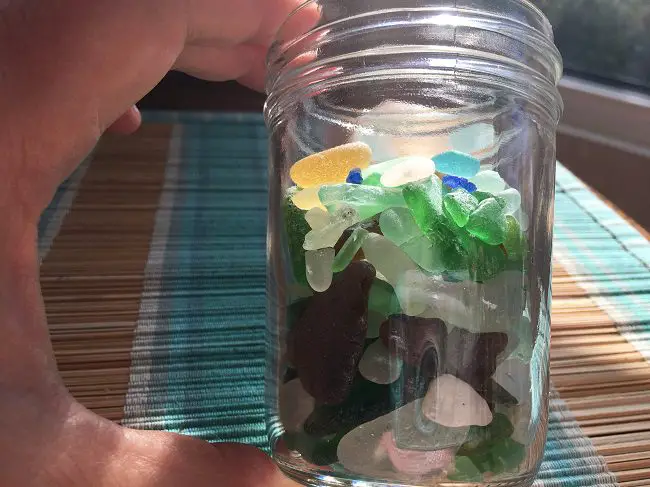
Common Sea Glass Colors
- Bright green
- Brown
- White (clear)
Uncommon Sea Glass Colors
- Soft green (sea foam)
- Soft Blue
- Forest Green
- Lime Green (like Sprite bottles)
- Golden Amber
- Amber
- Jade
Rare Sea Glass Colors
- Pink
- Aqua
- Dark/Bright Blue (cobalt/cornflower blues)
- Citron (dark yellow-green)
- Purple
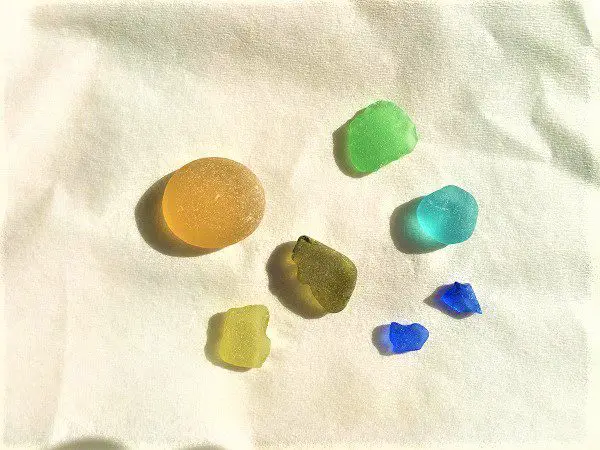
The large round yellow is an extremely rare find; the other colors are in the rare category.
Extremely Rare Sea Glass Colors
- Orange
- Red
- Turquoise
- Yellow
- Black (which are dark colors weathered to look black)
- Teal
- Gray
The most common colors you’ll find are kelly green (think St. Patrick’s day green), brown (like beer bottles), and white — which is clear glass that’s been tumbled to a mostly or totally opaque color.
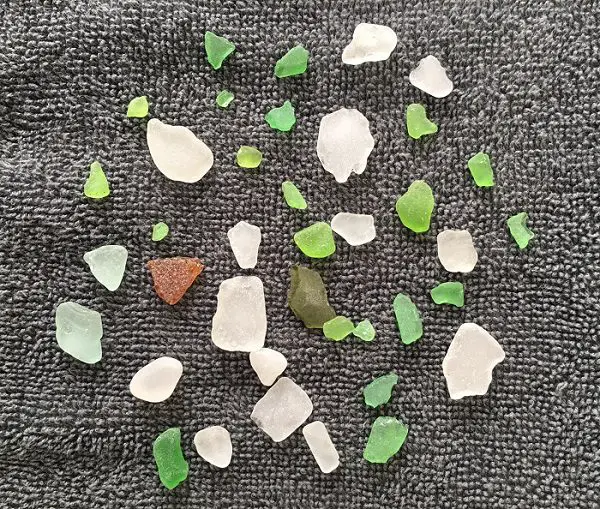
The real joy in collecting sea glass in this North County San Diego area is when you find gorgeous pieces that are outside of that common color category. Believe me, once you find your first special color, you’ll be hooked!
For a deeper dive into rare sea glass colors, you’ll love our article about the rarest color of all!
How can you tell if sea glass is real?
- It usually has a filmy, opaque quality instead of being shiny. Although some clear pieces may still be a bit see-through with some shine to them.
- The edges are smooth with no sharp corners. This is important. If sea glass still has sharp edges and a mostly shiny surface, it hasn’t aged enough in the sea. I throw these pieces back for another collector to find in the future.
- Authentic sea glass also has texture to it. It’s scratched and often dented a bit. If you hold it to light or shine a flashlight underneath, it will usually have bubbles throughout as well.
- After being tossed against things and rubbed repeatedly through sand for decades, sea glass loses its typical glass appearance and turns to treasure that’s prized by collectors all over the world.
Fake sea glass: how to tell
- Fake sea glass will look too uniform or perfect in shape or texture; it lacks the pitted texture and true frost opaqueness of real ocean-tumbled glass.
- It often has no texture or very little and can be quite smooth.
- If there are several pieces being sold together that are almost the exact same shape/size, it’s not real. You’d have to collect thousands of authentic pieces to come up with any that resemble each other.
- When you see rare colors being sold cheap, it’s not real. Rare sea glass is often valued in the hundreds of dollars and up.
- “Sea glass” earrings and other jewelry being sold in pairs that look alike and match are man-made in tumbling machines or frosted with chemicals. Real sea glass will never match.
- Hold fake sea glass up to the light and you won’t see any bubbles suspended (like aged sea glass has) or “c”-shaped indents and divots carved in the glass.
How old is sea glass?
That’s a great question. Many pieces of sea glass can give hints about their age or what they were in a “previous life”.
As we said earlier, sea glass is mostly discarded bottles, but can include dinnerware, fancy glassware, brightly colored medicine bottles and Noxema skin care jars — even poison bottles from centuries ago!
Speaking of poison and skin care glass, you’ll love our post about cobalt sea glass.
Really old sea glass is usually very thick since glass bottles had to hold up to plenty of shipping and handling in the dark ages. Liquors were a precious commodity at medieval feasts and the glass that held them was strong and reusable.
Another indication that sea glass might be very old is the appearance of tiny bubbles inside. If you hold a piece up to a bright window and you see little bubbles that look like the inside is carbonated like your favorite soda, it’s probably pretty old.
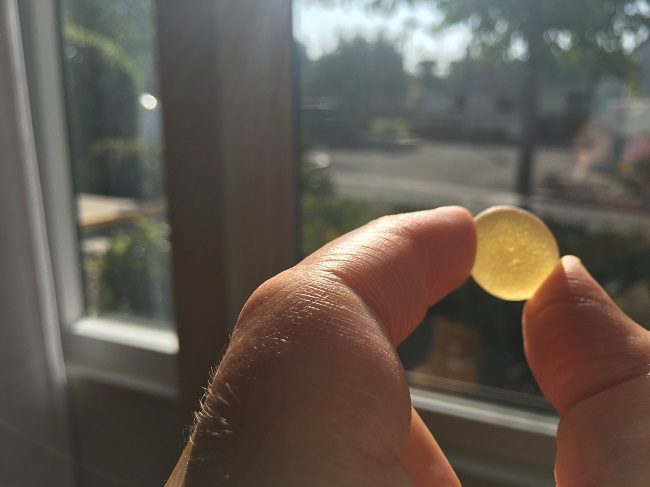
And the bubbles on the inside are also a good indicator of the old days of glass production.
Lots of tiny bubbles could mean the sea glass is from the 1700s, but if you see several larger bubbles, you might have found glass from the 1800s.
After the 1920s, glass production was more automated and less crude. The glass from the 20s until the present day contains few to no bubbles.
Sea glass colors can also provide great hints about the age of the pieces you find.
The rarest of sea glass colors were never mass produced, so there are far less of them. For example, Royal Ruby glass was first made in the 1930s, so most reds will be fairly old.
Deep shades of red glass were a prized possession among royal European households as early as the 1600s. If you ever find red, it’s a treasure for sure!
Sea glass in shades of green, brown, and blue can be quite old. Not all of them, of course, but some can. The most common colors of glass in earlier centuries were the browns, yellow-green (like wine bottles), and blues.
Many pieces of “black glass” could be from very early times as they’ve been weathered and conditioned by the sea to conceal the color they once were. You can only tell their original color by holding them to bright light.
How I became a collector
I began collecting sea glass after striking up a conversation with Swami Johnny (a local renowned surfer who’s surfed Swamis in Encinitas for decades) one day. Such a nice guy.
He asked if I’d ever found any sea glass at Swamis, to which I replied, “there’s sea glass here?!” He told me to start looking in the cobble (pebbles/small rocks) while I walk on the beach.
I did exactly that and found my first piece a month later. It was a natural high for sure. Sea glass reminds me of my grandmother who had her entire kitchen backsplash made of sea glass.
Each time I find a piece, it’s like finding a piece of her heart. The ocean was part of her soul … mine too.
Example of a find in Encinitas
How to find sea glass: top tips
- Search for glass at low tide. This gives you a few places to look … along the water edge where little shells and things are washing up as well as in the rocks further away from the surf.
- The top place to find glass is in the rocks — which reminds me, the top tip is to protect your feet with water shoes!
- It’s much easier to see bright colors among the rocks and sand on a sunny day with the sun behind you as you look.
- High-tide searching is okay also, but be prepared to walk only on rocks as there may not be much beach exposed. Wear good shoes and dig, dig, dig in those rocks. You’ll be rewarded.
- Bring a small ziploc or bag of some kind. I’ve lost pieces by putting them in my pocket.
- Avoid wearing your sunglasses if possible. They sometimes distort color and make sea glass harder to spot.
- Look ahead of you as well as down. It’s sometimes easier to see a piece laying a short ways from you than directly below.
- I use two techniques: sitting in the small rocks and digging carefully around (with my reading glasses on for better precision) and I also move rocks around quickly and keep my eyes moving around each pile I “disturb”. I find most of my bigger pieces by not being as “careful” and sort of madly pushing rocks around as I walk through large piles.
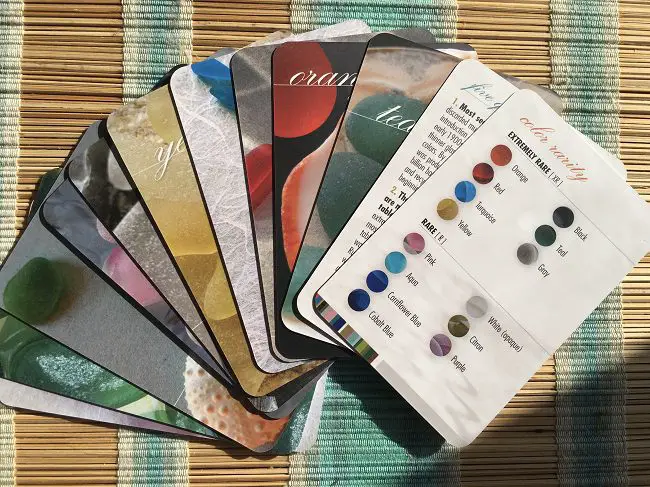
Sea glass collecting tools
There are a few tools I’d recommend for your sea glass collecting adventures.
My favorite by far are the deck of cards created by a sea glass collecting expert to help identify every type, color, and make of sea glass that’s out there.
These cards are fascinating to read and even more fun to put near your sea glass for easily identifying your colors, rarity, and other fun facts.
I might have to laminate my favorite few cards so I don’t love them to death too quickly.
There are even a few guides that tell all about the history of glass and some tips to identify what your sea glass might have been.
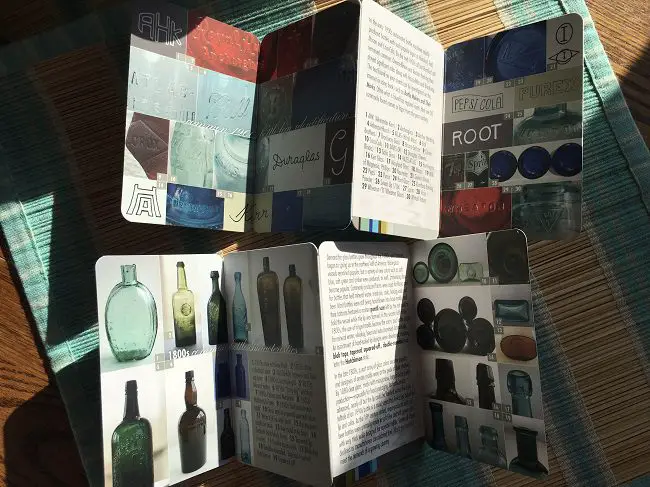
Helpful hand tools
The best hand tool I’ve invested in is a small handheld rake for gently moving small rocks and pebbles around. It saves the skin on your fingers. A beginner’s mistake you want to avoid.
This Japanese style claw rake is really sturdy and holds up nicely when moving medium and small sized rocks. I like the wide space between the tines as it helps to easily move larger rocks. The only downside is that smaller pieces may slip through more easily.
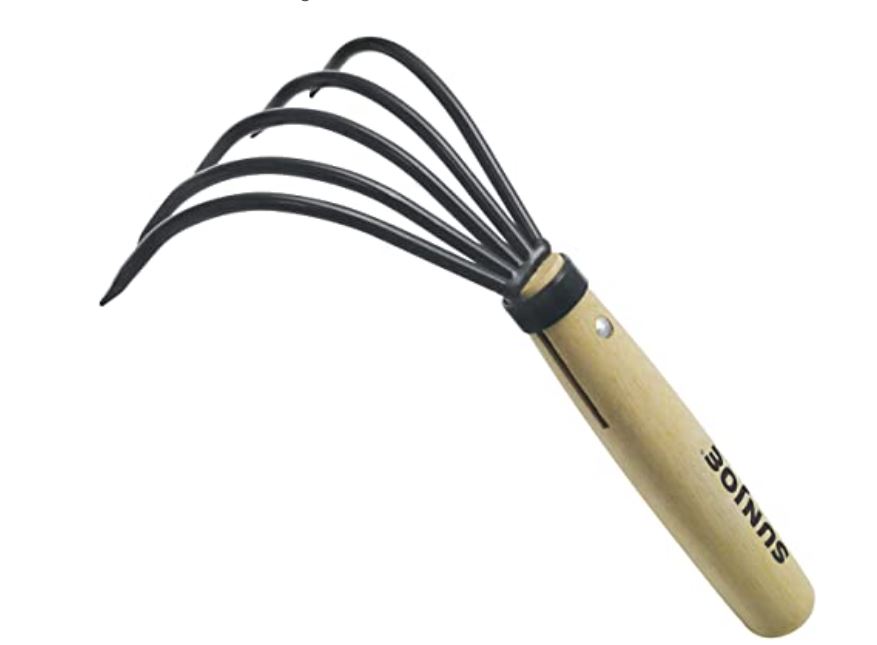
If you want a rake with tines that are closer together so glass won’t easily slip between rocks you’re moving, the mini gardening rake with comfortable handle is a good choice.
I liked how this one feels really sturdy but is easy to hold onto and doesn’t make my hand sore from gripping.
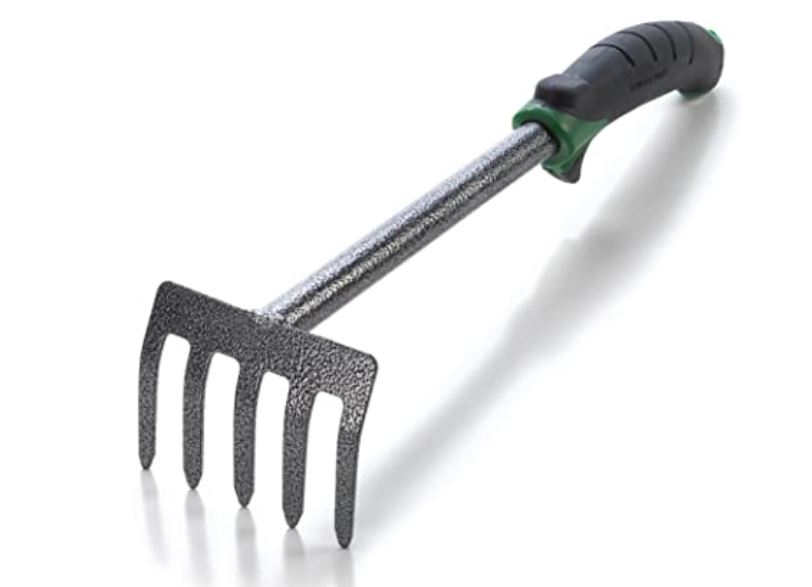
For safely storing and protecting my sea glass finds, I opted against plastic bags for these small mesh bags that can be easily rinsed and reused. They’re breathable and can easily be rinsed or washed so they won’t stink after putting sea treasures in. I especially love the loops on the zipper so I can attach a carabiner (keychain hook) to it and hang it from the belt loop of my pants. This keeps my treasure hunt as hands-free as possible!
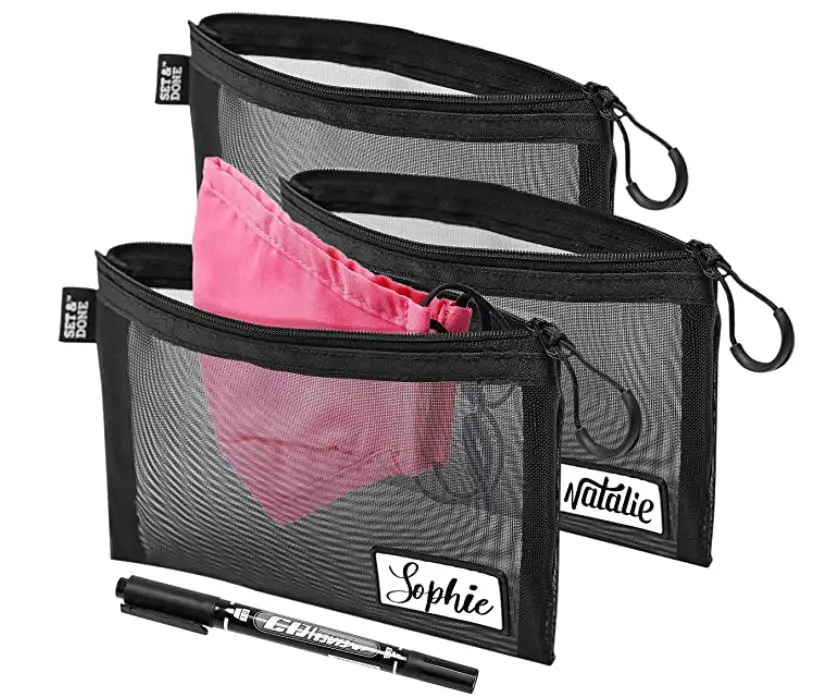
ONE LAST TIP:
I’ll leave you with one final tip for how to find sea glass in San Diego… or on your travels.
Above all, be patient. The adventure is in the hunt and process of discovering that sea glass can be on any beach. And don’t forget to look up from time to time and soak in the beauty of our coastline.
Our beaches are world-class and there’s truly something for everyone!
